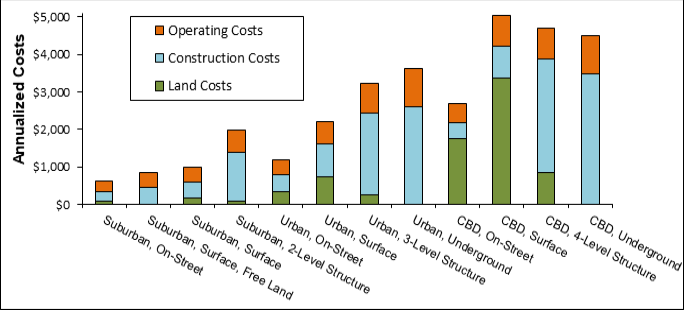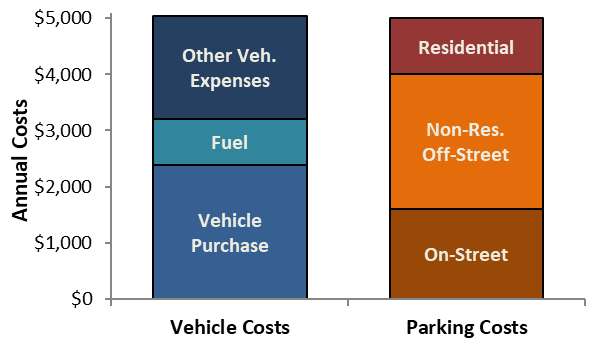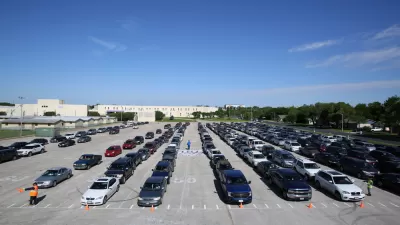Every time somebody purchases a vehicle they expect governments and businesses to provide parking for their use. These facilities are costly. For every dollar motorists spend on their vehicles somebody spends about a dollar on parking.

Parking facilities are a critical part of a transportation system: vehicles are typically parked about 23 hours per day and require parking at each destination. These facilities impose large economic, social and environmental costs. Information on these costs is important for policy and planning analysis.
Parking is the dark matter of the urban universe: it significantly affects development patterns, travel activity, affordability, livability and environmental impacts, but these impacts are virtually invisible. In the past, planners seldom considered the total costs, subsidies and inequities of decisions such as how much off-street parking to mandate or how on-street parking should be mandated and priced. However, this is starting to change.
A new open access article, Comprehensive Parking Supply, Cost and Price Analysis published in Transportation Research Procedia estimates the number of parking spaces per vehicle, their costs and prices. It summarizes a longer report of the same name.
New research improves our understanding of these costs. In the past parking supply (the number of parking spaces built in an area) was estimated using bottom-up methods: researchers simply assumed that each vehicle has about one parking space at home, one at work plus a share of spaces at other destinations, resulting in two to three spaces per vehicle. However, recent field surveys indicate that North American communities typically have three to eight parking spaces per vehicle, including many that are seldom-used but government-mandated. Their annualized costs, including land, construction and operating expenses, typically range from about $600 for basic surface parking on inexpensive land to more than $4,000 for high-amenity structured parking. Overall, their costs are estimated to average about $1,000 annually per space or $5,000 per vehicle-year, totaling more than a trillion dollars per year in the U.S.
Typical Annualized Parking Facility Costs

For every dollar motorists spend on their vehicles somebody spends about a dollar on parking. Most parking costs are external, increasing taxes, rents and retail prices. This is economically inefficient and unfair since it increases total parking and traffic costs, and forces households that drive less than average to subsidize higher-mileage motorists. This research justifies more efficient parking management which reduces the parking supply needed to serve demands.
Comparing Vehicle and Parking Costs

This research has important implications. It indicates that vehicle parking is much more costly, so efficient parking management and vehicle travel reduction policies provide much larger benefits, than generally recognized. Current policies are grossly unfair because they force households that own fewer than average vehicles to subsidize parking for those that own more than average vehicles, in part by increasing housing costs. Excessive parking also contributes to sprawl and impervious surface area, and therefore stormwater management costs and heat island effects.
More comprehensive information on these factors can result in better planning decisions.
FULL STORY: Comprehensive Parking Supply, Cost and Price Analysis

Manufactured Crisis: Losing the Nation’s Largest Source of Unsubsidized Affordable Housing
Manufactured housing communities have long been an affordable housing option for millions of people living in the U.S., but that affordability is disappearing rapidly. How did we get here?

Americans May Be Stuck — But Why?
Americans are moving a lot less than they once did, and that is a problem. While Yoni Applebaum, in his highly-publicized article Stuck, gets the reasons badly wrong, it's still important to ask: why are we moving so much less than before?

Using Old Oil and Gas Wells for Green Energy Storage
Penn State researchers have found that repurposing abandoned oil and gas wells for geothermal-assisted compressed-air energy storage can boost efficiency, reduce environmental risks, and support clean energy and job transitions.

San Antonio Remains Affordable as City Grows
The city’s active efforts to keep housing costs down through housing reforms and coordinated efforts among city agencies and developers have kept it one of the most affordable in the nation despite its rapid population growth.

What Forest Service Cuts Mean for Cities
U.S. Forest Service employees work on projects that have impacts far beyond remote, rural wilderness areas.

North Texas Transit Leaders Tout Benefits of TOD for Growing Region
At a summit focused on transit-oriented development, policymakers discussed how North Texas’ expanded light rail system can serve as a tool for economic growth.
Urban Design for Planners 1: Software Tools
This six-course series explores essential urban design concepts using open source software and equips planners with the tools they need to participate fully in the urban design process.
Planning for Universal Design
Learn the tools for implementing Universal Design in planning regulations.
Heyer Gruel & Associates PA
City of Moreno Valley
Institute for Housing and Urban Development Studies (IHS)
City of Grandview
Harvard GSD Executive Education
Salt Lake City
NYU Wagner Graduate School of Public Service
City of Cambridge, Maryland




























